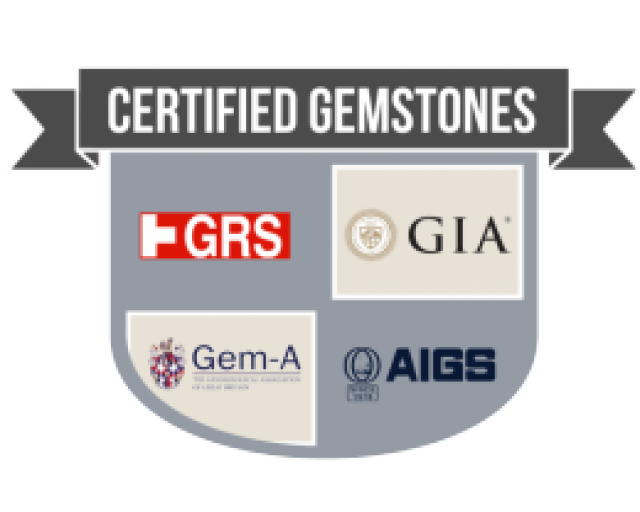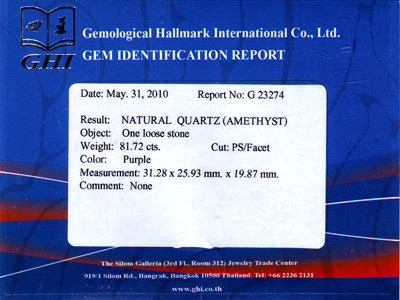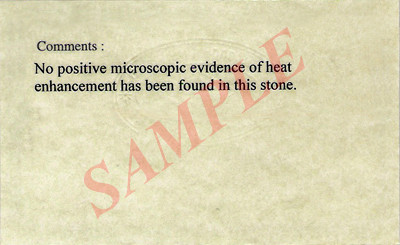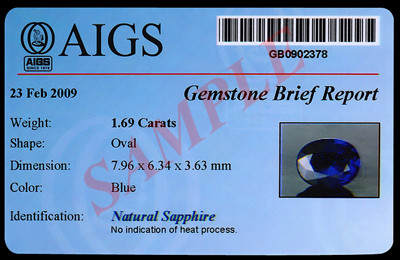 加工...
Certified Gemstones
认证宝石
该文本是机器翻译的。
显示原件?
加工...
Certified Gemstones
认证宝石
该文本是机器翻译的。
显示原件?
 加工...
加工...
 Gem Rock Auctions has one of the largest and most comprehensive ranges of certified gemstones listed on the Internet. This gives our buyers more confidence and trust when purchasing a natural gemstone. With over two thousand certified gemstones on line already it is a great place to starting shopping for gemstones online.
Gem Rock Auctions has one of the largest and most comprehensive ranges of certified gemstones listed on the Internet. This gives our buyers more confidence and trust when purchasing a natural gemstone. With over two thousand certified gemstones on line already it is a great place to starting shopping for gemstones online.
Our Gemstone Sheriff program also adds another layer of assurance by using the collective knowledge of a panel of gemologists to check any gemstone listed on our site. This is useful for gemstones that have not yet been certified.
Why Buying Certified Gemstones Is Important
The market is flooded with glass, plastic and synthetic gemstones. Over the years this has done great harm to the gemstone industry. Gem Rock Auctions is dedicated to selling only natural gemstones to our customers. Having a large selection of certified and tested gemstones ads to the confidence of buyers.
If you are looking to buy a gemstone for the first time and don’t know what some of the terms mean it is best to start with certified gemstones. That way you will know that each stone has been tested by experts (known as Gemologists) and is described 100% correctly.
To give you an example of a gemstone that has caused much confusion and pain for buyers over the years. This is Goldstone. It is sold around the world as a naturally occur gemstone with a beautiful sparkle. in reality this is a man made gemstone (primarily made of glass). You will never find a certified Goldstone because the gemological laboratories will call it Glass.

Certifying Gemstones
There are many reasons why some gemstone buyers want to buy a certified gemstone. More often than not however, they want to buy a certified stone for the assurance they receive from that certification.
Certification gives the buyer the assurance that what they are buying is the real thing. It’s also very helpful and simplifies the resale process, should they decide to later sell the stone.
Usually the gemstone you purchase will not be certified, so it is important to know your options in sending your new investment off to be certified.
When having a stone certified, there are many options available. Some are much better than others, so it’s important to consider all of your options. The cost of certification will also be something for you to consider. The more information you have on the certification, the more you will pay for it.
Different Kinds of Certification
- Brief Reports - This is typically the most inexpensive type of report/certificate you can get. These will give you the basics of the stone tested such as: stone type, weight, size, shape, clarity, & color. There may also be a comment section. In the brief report you will most likely not find the treatments the stone has received. However most times they will include heating/treatments for Sapphires and Rubies. The report will come in a plastic cover about the size of a credit card.
- Brief Report with Photo - These will have all of the information of the basic brief report, but will also include a picture of the stone being certified on the report itself not separate. EMIL of Japan, BGL, AIGS are some laboratories that do these types of reports. They do have some restrictions to the types of stones they will test. Quartz varieties are one they usually don’t test.
- Standard Reports - These reports come in a sealed card/envelope which include the gemstone inside of the report. There is a plastic cover on the back so you are able to see the stone. The information with these reports include: Type of stone, weight, cut, size/measurements, color, & a comment section. Treatments for Sapphires and Rubies will typically be noted in the comment section.
- Full Gemstone Report - This report comes in card form printed on original paper, will be laminated for protection, and will have the signature of the gemologist. This report will tell you the type of stone, description, size, shape, weight, color, clarity, proportion, finish grade, refractive index, specific gravity, variety & trade name, any treatments, and a photo of the gemstone.
Some laboratories will allow all types of stones, where some will have restrictions such as no Quartz or Pearl.
GHI, BGL, AIGS, GIT, GRS, EGL & GIA are some of the major laboratories that offer these types of certifications.
- Restrictions -You will find that some laboratories will not certify certain stones depending on the type of report you choose. You will also find a restriction on the size of stone depending on the report. Many times you will find that if a stone is over a particular weight (say 3 carats) that the price for the certification will increase dramatically.
- Price -The price you’ll pay will depend on the type of report that you buy, and will vary from lab to lab. You can expect to pay anywhere from $35-$200 for these types of reports.
- Time Frames to Certify -Depending on where you live and where the lab you choose is located will help determine the time frame you can expect on having your stone certified. 2-14 days is often the time frame given.
Other Important information
Always make sure if you are buying a stone that is already certified, that it has been certified from a third party, not from within the company you are buying from. It is not acceptable in the gem trade to certify your own stones and then sell them.
There are many trained gemologists that can identify gemstones, but it is always best to have your stone certified at a gemological laboratory specializing in gemstone testing. Gemstone labs will have the means to have the latest testing equipment and a reputation to maintain.
There are many labs around the world that are worthy of certifying your stones so you don’t have to choose the most popular ones (GIA, EGL ect.) However there are benefits to having them done by these distinguished companies as well. They often specialize and engage in leading edge research, and are the experts in their field where treatments are concerned. They are also now trying to certify the origin of the gemstone being tested, but it’s not normally necessary.
Deciding to have your stone certified is a personal choice. It’s highly recommended for those stones that are expensive or rare. It does offer confidence that you have a valuable stone especially when spending a large dollar amount. There are many great uncertified stones available as well. Just make sure to choose reputable dealers and sellers like the sellers on Gemrock Auctions.







What Does A Gemology Laboratory Do?
 A certified gemology laboratory will investigate a variety of diamonds, colored gemstones and pearls at their research facility.
A certified gemology laboratory will investigate a variety of diamonds, colored gemstones and pearls at their research facility.
There are several major areas in the world recognized for quality certified testing. The United States of America offers several certified laboratories being a major gemstone import / export location as well as Bangkok and Antwerp.
Gemologists in these facilities have academic training from major universities, combined with many years of laboratory experience in gem identification. In conducting gem research they use a variety of advanced scientific instruments.
These laboratories collaborate with a number of Gemological researchers from other Certified Gemologist Laboratory facilities. They all use the same unique access to a wide range of gem materials and worldwide gem-producing localities which allow them to conduct Gemological research that could be carried out by few other organizations.
This is the most important and significant difference in a CERTIFIED GEM and an APPRAISED / EVALUATED GEM! In today’s world a range of synthetic gem materials can be found in the jewelry trade. There are also a number of natural gem materials that have been treated in laboratories to improve their color or appearance.
These products have become increasingly sophisticated, and details of the growth or treatment process are not always revealed, a situation that will cause difficulty for a gemologist who may be visiting your facility for valuations/appraisals & identification. The appraiser is limited in identification when laboratory testing cannot be performed.
The focus of a certified gemologist Lab’s research program is to investigate natural, synthetic and treated gem materials to develop means of identifying them. Why? Because accurate identification is essential for proper disclosure of these goods at the time of their sale, and to maintain consumer confidence in the gem and jewelry industry.
Certified Laboratory Reported Gems VS Appraisal & Valuation
The certified gemstone is most desired over a valuation/appraisal because this gem is usually going to be sold and a buyer may want a report on the gem.
The positive aspect of using a Certified Laboratory is the lab constantly looks at new gem finds, new testing techniques, new treatment techniques and use the latest laboratory equipment needed for gem testing.
A visiting gemologist cannot provide ALL of these things and a permanent hire gemologist can only use what equipment he or his company owns. Many companies hire a Gemologist to visit there Jewelry store or company when a very large number or gems need valuation. The company using the site visiting gemologist many times buy rough and large quantities of gems needing valuation / appraisal at once.
This cost much less in comparison to sending 500 gems to a lab to have each gem tested. If a seller works directly with a mine and buys 500 pounds of rough they can have the rough tested for authenticity, then cut the rough into faceted gems, after the rough is cut into faceted gems they may still want a value placed on the faceted gems therefore a gemologist will provide that service in the end providing a APPRAISAL / VALUATION.

This is not the same as a CERTIFIED GEM… This does not mean the appraisal is worthless it tells the buyer exactly what their selling and that information can be passed on to buyers if the visiting gemologist has created a report ‘per gem’. Many services can be provided excluding laboratory testing.
Laboratory Research Typically Performs The Following Steps
- Determine what information is required by the customer, several Gemstone testing reports are available to customers, Some Certification reports simply offer the Gem type, Size, Cut, and Clarity and whether the gem is natural or lab created. Other certifications offer the above information and the gem is also tested for any treatments. There is usually an additional fee for gemstone treatment testing. When you read the words NATURAL GEM on a report this ONLY means the gem is mined from the earth, this does not mean the gem is not treated. If the seller has requested the Gem being certified to be tested for treatments you will Additional information on the report saying Treatment: Heat. If the treatment is something other than heat like irradiation that will be listed but Heat is considered a treatment and TREATMENTS are applied to gems in rough form in most cases.
- Obtain gem samples for scientific study. The data collected is of greatest research value when we know the origin of the samples—the geographic locality for a natural gemstone, or the growth method for a synthetic gem material, and the treatment method for a treated gem material. They should also try to examine a number of samples that represent the range of properties the gem can exhibit. This allows the testing laboratory to compare samples to the gem you may send for testing.
- Analyse the selected gem samples with a range of scientific equipment to document their properties systematically, and then incorporate the results into a database. Because of the high value of many gem materials, Laboratories are normally limited to non destructive analytical techniques.
- In characterizing gems, testings will focus on documenting visual features seen with the binocular microscope, absorption or luminescence spectra that result from light or other forms of energy interacting with the sample, and non-destructive or minimally destructive analysis of the sample’s chemical composition.
- Establish means of identifying the gem material by analysing the Certified Laboratories database of sample results. This is used for current and future testings.
- Disseminate the results of research through articles in Gemological journals and the jewelry industry trade. Certified Laboratories also require their working gemologist to further education by presentations at industry and scientific conferences on a regular basis, and our research is incorporated in Trade shows and continued education, the reason for this is New gemstones are found around the world that will need to be added to the laboratory database and treatments are updated and changed constantly to offer perfection to gem lovers.
- Certified Laboratories collaborate with other outside researchers or research facilities to acquire additional expertise, learn of new scientific instrument used in detecting gemstone and treatments, they also try to arrange for samples to be treated so they can study them before and after the enhancement process. This allows comparison of gems per gemstone family!
- Lastly a certified gemstone labatory will provide a report for any gemstone you send them for testing. Most ACCREDITED LABS will return these gems inside of a sealed pouch with a report. This will allow you to sell the gem showing the gem was tested for identification, size, treatments etc… What ever you paid for. This gem is sealed to show no type of tampering has occurred and the buyer is confident the same gem mentioned on the report is the gem bought. This is an added feature. If you look at the back of the CERTIFIED SEALED GEMSTONE pouch you will see notation: This gem report is null and void once open. So if you’re selling gems, having them tested do not open them upon return. Photograph them before you mail them for testing. Your gem is worth more once tested and the buyer cannot make any accusation that the gem sealed in the pouch is not the same gem on the report.
When you have a gem that is not sealed this does not mean the report is incorrect but a buyer may not be as confident with a valuation or appraisal as they are with a Certification. Appraisals are usually requested by a buyer who has already bought a gem so they may insure the gem, jewelry or piece in question. VALUATION also is usually provided to a seller who buys large quantities and they want verification the mine is giving them what they are paying for since there have been cased of gems being tampered with in the mine itself!
With any route you decide take to CERTIFY, APPRAISE or VALUATE your gem use an ACCREDITED GRADUATE GEMOLOGIST or LABORATORY who has GRADUATED from an ACCREDITED GEMOLOGICAL SCHOOL. Some gemologist schools allow students to take a few courses outside the school as well as testing. We do advise using an ACCREDITED GEMOLOGICAL SCHOOL & LABORATORY; most accredited laboratories also offer schools. This is where you will want your gems to be certified through.
Gemstone & Diamond Appraisal
Appraisal service should be performed by an independent appraiser. An appraisal should contain a quality analysis, description, and valuation ‘tell you the value’ of the gemstone or jewelry item. While Gem Rock Auctions cannot recommend individual appraisers, there are several national appraisal associations and networks that will be able to help you locate an appraiser in your area.

Many of these associations require their appraisers to have been a GRADUATE GEMOLOGIST as well as additional appraisal training. To locate an appraiser, check your local phone listings or contact one of the following appraisal associations. We discourage buying gems from sellers who offer appraisals on their own products, this service should come from a service outside the Sellers own company so valuations are accurate and not inflated. Some sellers do hire a Gemologist to come to there store or company and perform this service within their business when a large number or gems or jewelry pieces need appraisal / valuation. That seller should not be a regular employee of the company asking for appraisal. THIS SERVICE IS NOT A CERTIFICATION OF THE GEMS BEING APPRAISED, BUT ONLY AN APPRAISAL. Certification offers gemstone testing and other reports a Hired Gemologist cannot offer.
 Gem Rock Auctions 是互联网上列出的最大、最全面的认证宝石系列之一。这让我们的买家在购买天然宝石时更有信心和信任。网上已经有超过 2000 种经过认证的宝石,它是开始在线购买宝石的好地方。
Gem Rock Auctions 是互联网上列出的最大、最全面的认证宝石系列之一。这让我们的买家在购买天然宝石时更有信心和信任。网上已经有超过 2000 种经过认证的宝石,它是开始在线购买宝石的好地方。
我们的宝石警长计划还利用宝石学家小组的集体知识来检查我们网站上列出的任何宝石,从而增加了另一层保证。这对于尚未经过认证的宝石很有用。
为什么购买经过认证的宝石很重要
市场上充斥着玻璃、塑料和合成宝石。多年来,这对宝石行业造成了巨大损害。 Gem Rock Auctions 致力于只向我们的客户销售天然宝石。拥有大量经过认证和测试的宝石广告,以增强买家的信心。
如果您是第一次购买宝石并且不知道某些术语的含义,那么最好从经过认证的宝石开始。这样您就会知道每颗宝石都经过专家(称为宝石学家)的测试,并且描述 100% 正确。
给您举一个多年来给买家带来很多困惑和痛苦的宝石的例子。这是戈德斯通。它作为一种天然宝石销往世界各地,散发着美丽的光芒。事实上,这是一种人造宝石(主要由玻璃制成)。您永远找不到经过认证的金石,因为宝石实验室将其称为玻璃。

认证宝石
一些宝石买家想要购买经过认证的宝石的原因有很多。然而,他们通常希望购买经过认证的宝石,以获得该认证的保证。
认证可以让买家确信他们购买的是正品。如果他们决定稍后出售宝石,这也非常有帮助,并简化了转售过程。
通常,您购买的宝石不会经过认证,因此了解将新投资送去认证的选择非常重要。
当石材获得认证时,有多种选择。有些比其他要好得多,因此考虑所有选择很重要。认证费用也是您需要考虑的事情。您掌握的认证信息越多,您为此支付的费用就越多。
不同类型的认证
- 简要报告- 这通常是您可以获得的最便宜的报告/证书类型。这些将为您提供所测试宝石的基本信息,例如:宝石类型、重量、尺寸、形状、净度和颜色。可能还会有评论区。在简短的报告中,您很可能找不到石头所接受的处理方法。然而,大多数情况下,它们会包括对蓝宝石和红宝石的加热/处理。该报告将采用信用卡大小的塑料封面包装。
- 带照片的简要报告- 这些将包含基本简要报告的所有信息,但还将包括报告本身上经过认证的宝石的图片,而不是单独的。日本的EMIL、BGL、AIGS是做这类报告的一些实验室。他们对测试的宝石类型确实有一些限制。他们通常不测试石英品种。
- 标准报告- 这些报告装在密封的卡片/信封中,其中包括报告内的宝石。背面有一个塑料盖,因此您可以看到石头。这些报告的信息包括:宝石类型、重量、切工、尺寸/尺寸、颜色和评论部分。蓝宝石和红宝石的处理方法通常会在评论部分注明。
- 完整的宝石报告- 该报告以卡片形式打印在原纸上,将进行层压保护,并有宝石学家的签名。该报告将告诉您宝石的类型、描述、尺寸、形状、重量、颜色、净度、比例、成品等级、折射率、比重、品种和商品名称、任何处理以及宝石的照片。
一些实验室允许使用所有类型的宝石,而有些实验室则有限制,例如不允许使用石英或珍珠。
GHI、BGL、AIGS、GIT、GRS、EGL 和 GIA 是提供此类认证的一些主要实验室。
- 限制 -您会发现一些实验室不会根据您选择的报告类型对某些宝石进行认证。根据报告,您还会发现对宝石尺寸的限制。很多时候您会发现,如果宝石超过特定重量(例如 3 克拉),认证价格将会大幅上涨。
- 价格 -您需要支付的价格取决于您购买的报告类型,并且因实验室而异。您可能需要为这些类型的报告支付 35 至 200 美元不等的费用。
- 认证的时间范围 -根据您居住的地方和您选择的实验室所在的位置,将有助于确定您的宝石获得认证所需的时间范围。通常给出的时间范围是 2-14 天。
其他重要信息
如果您购买的宝石已经过认证,请务必确保它是由第三方而非您购买的公司内部认证的。在宝石贸易中,对自己的宝石进行认证然后出售是不可接受的。
有许多训练有素的宝石学家可以识别宝石,但最好让您的宝石在专门从事宝石测试的宝石学实验室进行认证。宝石实验室将有能力拥有最新的测试设备并维持声誉。
世界各地有许多实验室值得对您的宝石进行认证,因此您不必选择最受欢迎的实验室(GIA、EGL 等),但是由这些杰出的公司进行认证也有好处。他们通常专注于前沿研究,并且是治疗相关领域的专家。他们现在还试图证明正在测试的宝石的来源,但这通常是没有必要的。
决定让您的石材获得认证是个人的选择。强烈推荐用于那些昂贵或稀有的宝石。它确实让您相信您拥有一颗有价值的宝石,尤其是在花费大量美元时。还有许多未经认证的优质宝石可供选择。只需确保选择信誉良好的经销商和卖家,例如 Gemrock Auctions 上的卖家。







宝石学实验室做什么?
 经过认证的宝石学实验室将在其研究设施中研究各种钻石、有色宝石和珍珠。
经过认证的宝石学实验室将在其研究设施中研究各种钻石、有色宝石和珍珠。
世界上有几个主要领域被认可进行质量认证测试。美国作为主要的宝石进出口地以及曼谷和安特卫普,拥有多个经过认证的实验室。
这些设施中的宝石学家接受过主要大学的学术培训,并结合了多年的宝石鉴定实验室经验。在进行宝石研究时,他们使用各种先进的科学仪器。
这些实验室与其他认证宝石学家实验室机构的许多宝石学研究人员合作。他们都使用相同的独特途径访问各种宝石材料和全球宝石产地,这使他们能够进行很少有其他组织可以进行的宝石学研究。
这是认证 GEM 和评估/评估 GEM 中最重要和最显着的区别!当今世界,珠宝贸易中可以找到一系列合成宝石材料。还有许多天然宝石材料经过实验室处理以改善其颜色或外观。
这些产品变得越来越复杂,并且生长或处理过程的细节并不总是被揭示,这种情况会给可能访问您的工厂进行估价/鉴定和鉴定的宝石学家带来困难。当无法进行实验室测试时,评估员的鉴定能力受到限制。
认证宝石学家实验室的研究计划的重点是研究天然、合成和处理过的宝石材料,以开发识别它们的方法。为什么?因为准确的识别对于在销售时正确披露这些商品以及保持消费者对宝石和珠宝行业的信心至关重要。
认证实验室报告的宝石 VS 鉴定与估价
经过认证的宝石比估价/估价更受欢迎,因为这种宝石通常会被出售,而买家可能需要一份有关宝石的报告。
使用认证实验室的积极方面是实验室不断寻找新的宝石发现、新的测试技术、新的处理技术,并使用宝石测试所需的最新实验室设备。
来访的宝石学家无法提供所有这些东西,而长期雇用的宝石学家只能使用他或他的公司拥有的设备。当大量宝石需要估价时,许多公司都会聘请宝石学家前往珠宝店或公司。该公司利用该网站多次拜访宝石学家,一次性购买大量需要估价/鉴定的宝石。
与将 500 颗宝石送到实验室对每颗宝石进行测试相比,成本要低得多。如果卖家直接与矿山合作并购买 500 磅原石,他们可以对原石进行真伪测试,然后将原石切割成刻面宝石,在将原石切割成刻面宝石后,他们可能仍然希望对刻面宝石进行估价因此,宝石学家最终将提供评估/估价服务。

这与认证宝石不同……这并不意味着评估毫无价值,它准确地告诉买家他们出售的是什么,如果来访的宝石学家已创建“每颗宝石”的报告,则该信息可以传递给买家。可以提供除实验室测试之外的许多服务。
实验室研究通常执行以下步骤
- 确定客户需要哪些信息,客户可以获得一些宝石测试报告,一些认证报告仅提供宝石类型、尺寸、切工和净度以及宝石是天然宝石还是实验室制造的。其他认证提供上述信息,并且宝石也经过了任何处理测试。宝石处理测试通常需要支付额外费用。当您在报告上看到“天然宝石”一词时,这仅意味着该宝石是从地球上开采的,并不意味着该宝石未经处理。如果卖家要求对经过认证的宝石进行处理测试,您将在报告上看到“处理:加热”的附加信息。如果处理不是加热(如辐射),则会列出,但加热被视为一种处理,并且在大多数情况下,处理适用于原石形式的宝石。
- 获取用于科学研究的宝石样品。当我们了解样品的来源(天然宝石的地理位置、合成宝石材料的生长方法以及经过处理的宝石材料的处理方法)时,收集的数据具有最大的研究价值。他们还应该尝试检查一些代表宝石可以表现出的特性范围的样品。这使得测试实验室可以将样品与您可能发送进行测试的宝石进行比较。
- 使用一系列科学设备分析选定的宝石样本,系统地记录其特性,然后将结果纳入数据库。由于许多宝石材料的价值很高,实验室通常仅限于无损分析技术。
- 在表征宝石时,测试将侧重于记录用双目显微镜看到的视觉特征、光或其他形式的能量与样品相互作用产生的吸收或发光光谱,以及对样品化学成分的无损或最小破坏性分析。
- 通过分析认证实验室的样品结果数据库,建立鉴定宝石材料的方法。这用于当前和未来的测试。
- 通过宝石学期刊和珠宝行业贸易中的文章传播研究成果。认证实验室还要求他们的工作宝石学家定期在行业和科学会议上进行演讲,以进一步接受教育,我们的研究被纳入贸易展览和继续教育中,原因是世界各地发现了新的宝石,需要添加到实验室数据库中,处理方法不断更新和改变,为宝石爱好者提供完美的产品。
- 认证实验室与其他外部研究人员或研究机构合作,以获得额外的专业知识,了解用于检测宝石和处理的新科学仪器,他们还尝试安排样品进行处理,以便他们可以在增强过程之前和之后进行研究。这样可以比较每个宝石家族的宝石!
- 最后,经过认证的宝石实验室将为您送去测试的任何宝石提供一份报告。大多数认可实验室会将这些宝石装在密封袋中并附有报告。这将允许您出售宝石,显示宝石经过了鉴定、尺寸、处理等测试……无论您支付了什么费用。这颗宝石被密封,以表明没有发生任何类型的篡改,买家确信报告中提到的宝石就是所购买的宝石。这是一个附加功能。如果您查看认证密封宝石袋的背面,您会看到注释:此宝石报告一旦打开即无效。因此,如果您要出售宝石,请对其进行测试,不要在退货时打开它们。在邮寄它们进行测试之前先给它们拍照。经过测试后,您的宝石的价值会更高,买家不能指责密封在袋子中的宝石与报告上的宝石不同。
当您拥有未密封的宝石时,这并不意味着报告不正确,但买家对估价或鉴定的信心可能不如对认证的信心。已购买宝石的买家通常会要求进行评估,以便他们可以为相关宝石、珠宝或单品投保。估价通常也会提供给购买大量货物的卖家,他们希望验证矿山是否给了他们所支付的价格,因为矿山本身曾发生过宝石被篡改的情况!
无论您决定采取何种方式对您的宝石进行认证、评估或估价,都请使用经过认证的研究生宝石学家或从经认证的宝石学校毕业的实验室。一些宝石学院允许学生参加校外的一些课程以及测试。我们建议您使用经过认证的宝石学校和实验室;大多数经过认可的实验室也提供学校。这是您希望您的宝石通过认证的地方。
宝石和钻石鉴定
评估服务应由独立评估师进行。评估应包含质量分析、描述和估价,以“告诉您宝石或珠宝的价值”。虽然 Gem Rock Auctions 无法推荐个人评估师,但有几个国家评估协会和网络可以帮助您找到您所在地区的评估师。

许多此类协会要求其评估师必须是研究生宝石学家,并接受过额外的评估培训。要找到评估师,请检查您当地的电话列表或联系以下评估协会之一。我们不鼓励从对自己的产品提供评估的卖家那里购买宝石,这项服务应该来自卖家自己公司之外的服务,因此估价准确且不会夸大。当大量宝石或珠宝需要评估/估价时,一些卖家确实会聘请宝石学家来到商店或公司并在其业务范围内提供这项服务。该卖家不应是要求评估的公司的正式员工。本服务并非宝石被评估的证明,而只是评估。认证提供宝石测试和雇佣宝石学家无法提供的其他报告。
本文是否有帮助?
9人认为这篇文章很有帮助
Gem Rock Auctions
- Written - 11th Jan 2011
- Edited - 1st Aug 2023















